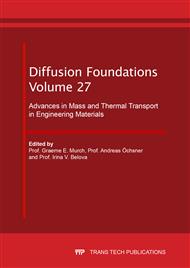p.25
p.35
p.40
p.50
p.63
p.73
p.90
p.99
p.115
Transport Coefficients of Ammonia Gas in Thermoplastic Polymers and Nanocomposites Used for Microelectronic Substrates Containers
Abstract:
Polymeric plastic boxes (named Front Opening Unified Pods (FOUP)) were widely used in semiconductor manufacture to maintain the cleanliness of processed wafer substrates in a controlled mini-environment. Polymeric materials, however, are able to sorb airborne molecular contaminants (AMCs) and subsequently to outgas the sorbed AMCs backward to FOUP’s atmosphere, causing the transfer of AMCs to sensitive stored substrates, named cross-contamination. As a type of AMCs, the NH3 cross-contamination could cause a severe yield loss to integrated circuits (crystals (haze), resist-development defects (T-topping) or metallic corrosion). Experiments were carried out to establish the NH3 sorption and desorption kinetics in polyetherimide (PEI), Entegris Barrier Material (EBM)), and EBM/carbon nanotubes (EBMCNT) at NH3 concentration of 800-ppbv, 21°C, and relative humidity of 40%. The transport coefficients i.e. solubility and diffusivity (DNH3 and SNH3) were then determined. The study on NH3 provides an additional guideline to choose the best raw materials for FOUP formulation in taking into account the potential cross-contamination of AMCs. Numerical simulation model based on obtained solubility and diffusivity values was conducted to demonstrate NH3 concentration profiles in FOUP walls during contamination and FOUP decontamination, which are inaccessible by conventional experiments.
Info:
Periodical:
Pages:
63-72
Citation:
Online since:
May 2020
Price:
Сopyright:
© 2020 Trans Tech Publications Ltd. All Rights Reserved
Share:
Citation:


